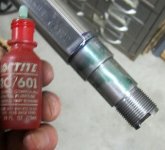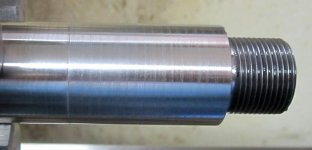Hey guys, I have another question about a possibly controversial and contested subject. I am honestly curious, and not trying to start any fights here. My question is about the use of Loctite. I am an industrial mechanic by trade, and have used loctite hundreds of times. I am new to the world of DIY AR rifles, however, and some of the stuff I see just doesn't add up in my mind.
First, I have always been told that Loctite is useless where extreme heat is present. I don't remember ever hearing what exactly these temperature extremes may be, but I am thinking that barrels and gas blocks would qualify.
So, as I ponder all the different things I have seen about building AR's (mostly on YouTube), I see things that don't add up. Some of the offerings are clearly sub par, and the guys posting them have no business trying to educate anybody, but others seem to know plenty, but still generate questions in my mind.
What are your feelings about using Loctite on gas block set screws? How about Loctite around the barrel extension, prior to sliding it into the upper receiver (the claim being improved accuracy)? Seems like silly speculation to me, but I could be wrong, hence this post.
On a side note, why use a set screw style gas block? I have only built one AR, but I opted for a pinch screw style low profile unit by Vltor. A little more expensive, but in my mind, mechanically superior, and won't damage the barrel or require dimpling.
The other thing that stands out, is the use of gobs of grease on the upper receiver threads where the barrel nut goes. I understand the difference in torque values for dry vs wet, but a thin film is all that is needed. When I assembled my barrel to the upper, I used a plumbers flux brush to apply a thin film of Slipstream grease, and torqued the nut on to the specified 50 ft lbs, and moved on (my barrel nut needed no gas tube alignment).
So anyway, that is all I have on my mind for the moment. Like I said, not trying to stir the pot, just checking myself. I have pretty good general mechanical knowledge, but most of you know a lot more about guns than I do, and I appreciate you reading all of this and providing any thoughts you may have on the subject.
First, I have always been told that Loctite is useless where extreme heat is present. I don't remember ever hearing what exactly these temperature extremes may be, but I am thinking that barrels and gas blocks would qualify.
So, as I ponder all the different things I have seen about building AR's (mostly on YouTube), I see things that don't add up. Some of the offerings are clearly sub par, and the guys posting them have no business trying to educate anybody, but others seem to know plenty, but still generate questions in my mind.
What are your feelings about using Loctite on gas block set screws? How about Loctite around the barrel extension, prior to sliding it into the upper receiver (the claim being improved accuracy)? Seems like silly speculation to me, but I could be wrong, hence this post.
On a side note, why use a set screw style gas block? I have only built one AR, but I opted for a pinch screw style low profile unit by Vltor. A little more expensive, but in my mind, mechanically superior, and won't damage the barrel or require dimpling.
The other thing that stands out, is the use of gobs of grease on the upper receiver threads where the barrel nut goes. I understand the difference in torque values for dry vs wet, but a thin film is all that is needed. When I assembled my barrel to the upper, I used a plumbers flux brush to apply a thin film of Slipstream grease, and torqued the nut on to the specified 50 ft lbs, and moved on (my barrel nut needed no gas tube alignment).
So anyway, that is all I have on my mind for the moment. Like I said, not trying to stir the pot, just checking myself. I have pretty good general mechanical knowledge, but most of you know a lot more about guns than I do, and I appreciate you reading all of this and providing any thoughts you may have on the subject.


